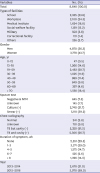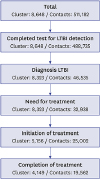1. World Health Organization. Global Tuberculosis Report 2017. Geneva: World Health Organization;2017.
2. Korea Centers for Disease Control & Prevention (KCDC). 2017 National Tuberculosis Control Guideline. Cheongju: KCDC;2017.
3. Kim HW, Kim JS. Treatment of latent tuberculosis infection and its clinical efficacy. Tuberc Respir Dis (Seoul). 2018; 81(1):6–12.

4. Choi JC. Diagnosis and treatment of latent tuberculosis infection. J Korean Med Assoc. 2014; 57(1):12–18.

5. Korea Centers for Disease Control & Prevention (KCDC). Guidelines for Management of Tuberculosis Epidemiological Investigation. Cheongju: KCDC;2012.
6. Eun BW, Kwon YH, Lee YK. Contact investigation for tuberculosis among children and adolescents in Korea, 2013–2015. Public Health Wkly Rep. 2016; 9(39):776–778.
7. Lee PH, Chang FY. Latent infection treatment to prevent TB transmission in school settings. J Formos Med Assoc. 2012; 111(10):525–526.

8. Jung DH, Jo KW, Shim TS. Prevalence of latent tuberculosis infection among medical students in South Korea. Tuberc Respir Dis (Seoul). 2012; 73(4):219–223.

9. Pan SW, Kou YR, Hu TM, Wu YC, Lee YC, Feng JY, et al. Assessment of latent tuberculosis infection in psychiatric inpatients: a survey after tuberculosis outbreaks. J Microbiol Immunol Infect. 2016; 49(4):575–583.

10. He GX, van den Hof S, van der Werf MJ, Wang GJ, Ma SW, Zhao DY, et al. Infection control and the burden of tuberculosis infection and disease in health care workers in china: a cross-sectional study. BMC Infect Dis. 2010; 10(1):313.

11. Jo KW, Hong Y, Park JS, Bae IG, Eom JS, Lee SR, et al. Prevalence of latent tuberculosis infection among health care workers in South Korea: a multicenter study. Tuberc Respir Dis (Seoul). 2013; 75(1):18–24.

12. Park YS, Cheong K. A case study of pulmonary tuberculosis outbreak in a facility for the physically or mentally disabled. In : Proceeding of the 50th Fall Conference of the Korean Society for Preventive Medicine; 1988 Oct 1; place unknown. Seoul: Korean Society for Preventive Medicine;1988. p. 131–132.
13. Hwang J, Cheong J, Choi BS. Prevalence of and risk factors for latent tuberculosis infection among employees at a workers' compensation hospital. J Korean Soc Occup Environ Hyg. 2017; 27(3):238–244.
14. Choi CM, Kang CI, Kim DH, Kim CH, Kim HJ, Lee CH, et al. The role of TST in the diagnosis of latent tuberculosis infection among military personnel in South Korea. Int J Tuberc Lung Dis. 2006; 10(12):1342–1346.
15. Moon CG, Park SJ, Cho MG, Kim YJ, Kim SY, Kim YK, et al. Clinical characteristics of tuberculosis in combat and auxiliary police in Korea. Infect Chemother. 2006; 38(6):383–388.
16. Ji SH, Kim HJ, Choi CM. Management of tuberculosis outbreak in a small military unit following the Korean national guideline. Tuberc Respir Dis (Seoul). 2007; 62(1):5–10.

17. Lobato MN, Leary LS, Simone PM. Treatment for latent TB in correctional facilities: a challenge for TB elimination. Am J Prev Med. 2003; 24(3):249–253.
18. García-Guerrero J, Marco Mouriño A, Sáiz de la Hoya Zamácola P, Vera-Remartínez EJ. Grupo de estudio PREVALHEP de prisiones. Multi-centre study of the prevalence of latent tuberculosis infection amongst inmates in Spanish prisons. Rev Esp Sanid Penit. 2010; 12(3):79–85.
19. Dara M, Acosta CD, Melchers NV, Al-Darraji HA, Chorgoliani D, Reyes H, et al. Tuberculosis control in prisons: current situation and research gaps. Int J Infect Dis. 2015; 32:111–117.

20. Carbone AS, Paião DS, Sgarbi RV, Lemos EF, Cazanti RF, Ota MM, et al. Active and latent tuberculosis in Brazilian correctional facilities: a cross-sectional study. BMC Infect Dis. 2015; 15(1):24.

21. Wang HY, Wang KC, Tsai SH, Lai PF, Lin WC, Lee HC, et al. A tuberculosis outbreak at a workplace in Central Taiwan, 2016. Taiwan Epidemiol Bull. 2018; 34(4):59–64.
22. Kawatsu L, Uchimura K, Ohkado A. Trend and treatment status of latent tuberculosis infection patients in Japan - Analysis of Japan TB surveillance data. PLoS One. 2017; 12(11):e0186588.

23. Goswami ND, Gadkowski LB, Piedrahita C, Bissette D, Ahearn MA, Blain ML, et al. Predictors of latent tuberculosis treatment initiation and completion at a U.S. public health clinic: a prospective cohort study. BMC Public Health. 2012; 12(1):468.

24. Stagg HR, Zenner D, Harris RJ, Muñoz L, Lipman MC, Abubakar I. Treatment of latent tuberculosis infection: a network meta-analysis. Ann Intern Med. 2014; 161(6):419–428.
25. Kan B, Kalin M, Bruchfeld J. Completing treatment for latent tuberculosis: patient background matters. Int J Tuberc Lung Dis. 2013; 17(5):597–602.

26. Fox GJ, Barry SE, Britton WJ, Marks GB. Contact investigation for tuberculosis: a systematic review and meta-analysis. Eur Respir J. 2013; 41(1):140–156.

27. Jaganath D, Zalwango S, Okware B, Nsereko M, Kisingo H, Malone L, et al. Contact investigation for active tuberculosis among child contacts in Uganda. Clin Infect Dis. 2013; 57(12):1685–1692.

28. Park JS. Prevalence and risk factors for Mycobacterium tuberculosis infection among contacts of pulmonary tuberculosis patients. Tuberc Respir Dis (Seoul). 2012; 72(2):140–148.
29. Kawachi I, Berkman LF. Neighborhoods and Health. New York, NY: Oxford University Press;2003.
30. Larsen K, Merlo J. Appropriate assessment of neighborhood effects on individual health: integrating random and fixed effects in multilevel logistic regression. Am J Epidemiol. 2005; 161(1):81–88.

31. Sanagou M, Wolfe R, Forbes A, Reid CM. Hospital-level associations with 30-day patient mortality after cardiac surgery: a tutorial on the application and interpretation of marginal and multilevel logistic regression. BMC Med Res Methodol. 2012; 12(1):28.

32. Matozinhos FP, Gomes CS, Andrade AC, Mendes LL, Pessoa MC, Friche AA, et al. Neighbourhood environments and obesity among adults: a multilevel analysis of an urban Brazilian context. Prev Med Rep. 2015; 2:337–341.

35. Health Insurance Review & Assessment Service. 2017 Health Insurance Statistical Yearbook. Seoul: National Health Insurance Service;2018.
37. Cho KS. Tuberculosis control in the Republic of Korea. Epidemiol Health. 2018; 40:e2018036.

38. Cho KS. Tuberculosis control in the Republic of Korea. Health Soc Welf Rev. 2017; 37(4):179–212.








 PDF
PDF Citation
Citation Print
Print










 XML Download
XML Download